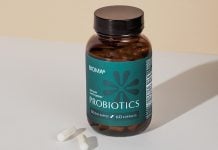
This post may contain affiliate content from which we earn a small commission at no additional cost to you. Read our full disclosure.
Ever pushed yourself in a workout and later felt like your muscles decided to throw a surprise party without inviting you? Well, that’s DOMS – Delayed Onset Muscle Soreness – giving you a not-so-welcome hello.
But fret not! In this friendly chat, we’ll unravel the mysteries of DOMS and learn how to be the boss of those achy muscles. So, buckle up as we dive into the world of Understanding and Managing DOMS (Delayed Onset Muscle Soreness). Let’s turn those post-workout woes into a tale of triumph!
The Science Behind DOMS

DOMS is a complex physiological response that occurs when muscles are exposed to unfamiliar or intense activities. Contrary to popular belief, it is not solely caused by the buildup of lactic acid, but rather by microscopic damage to muscle fibers and the subsequent inflammatory response.
Eccentric contractions, where muscles lengthen while under tension, are particularly implicated in DOMS. The stress placed on muscle fibers during eccentric movements triggers inflammation, leading to the characteristic soreness associated with DOMS.
The Role of Microscopic Muscle Damage
Engaging in activities that involve eccentric contractions, such as downhill running or resistance training, can result in microscopic tears in muscle fibers.
This damage initiates an inflammatory response, with the body’s immune system rushing to repair and remodel the affected tissues. This process, while essential for muscle growth and adaptation, is also responsible for the discomfort and soreness associated with DOMS.
Is DOMS a sign of a ‘good’ workout?
Some people believe that if you don’t feel very sore after every workout, you’re not getting any fitter. But that’s not true. When you begin a new exercise routine or challenge yourself, you might feel sore. However, as you continue working out, your body gets used to it.
You might feel less and less sore after each workout, but that doesn’t mean you’re not exercising well or not gaining fitness benefits.
Individual Variability in DOMS

Not everyone experiences DOMS to the same extent, and the severity can vary based on factors such as fitness level, age, and genetics.
Individuals who are new to a particular type of exercise or those who increase the intensity of their workouts may be more prone to DOMS. Understanding one’s own susceptibility to DOMS is crucial in tailoring a fitness routine that minimizes discomfort without compromising progress.
Preventing DOMS
- Drink water: When you exercise, especially in hot weather, drink water before, during, and after. It can help make your muscles less sore.
- Warm-up: Spend 5 to 10 minutes stretching before you start your workout. Don’t hold the stretches, just move your body gently. Save the still stretches for after you finish.
- Cool down: After your workout, do 20 minutes of easy cycling or walking. It can make your muscles less sore later. Finish with some slow stretches. They won’t stop muscle soreness, but they can make your joints and muscles more flexible.
- Take it easy: Don’t push yourself too hard. Increase the difficulty of your workouts gradually. This way, you can get stronger without feeling too sore.
When to Seek Medical Help
Muscle soreness after exercise usually doesn’t need a doctor, but it’s essential to pay attention to how you feel. If the pain makes it hard to do your usual activities, the American Council on Sports Medicine suggests seeing a doctor or nurse.
You should also see a doctor if:
- Your muscle pain lasts more than a week.
- Your pee becomes very dark.
- Your arms or legs swell a lot.
In rare cases, people with muscle soreness can get a serious condition called compartment syndrome. It causes extreme pain, and if you experience sharp pain, muscle spasms, or numbness after working out, talk to your doctor right away.
It’s important to listen to your body and seek help if you have unusual symptoms.
The Role of Active Recovery

Contrary to complete rest, engaging in light, low-impact activities during the recovery phase, known as active recovery, can help alleviate DOMS symptoms.
Activities like walking, swimming, or cycling stimulate blood flow to the muscles without causing additional stress. This increased circulation aids in the removal of metabolic byproducts and promotes faster healing.
Incorporating Flexibility and Mobility Exercises
Improving flexibility and mobility can contribute to preventing DOMS by enhancing the muscles’ ability to withstand various types of stress. Including dynamic stretches and mobility exercises in the warm-up routine can prepare the muscles for the specific movements involved in the workout, reducing the risk of microscopic damage.
The Importance of Adequate Sleep
In the realm of managing DOMS, the significance of quality sleep should not be overlooked. During sleep, the body undergoes crucial processes for recovery and repair. Adequate rest ensures the release of growth hormone, which plays a vital role in muscle regeneration.
Establishing a consistent sleep routine, aiming for 7-9 hours per night, can significantly contribute to minimizing the impact of DOMS and promoting overall well-being.
Mind-Body Techniques for DOMS Management

Beyond the physical aspects, incorporating mind-body techniques can also be beneficial in managing DOMS. Practices such as yoga and meditation help reduce stress, which, in turn, can positively impact the body’s inflammatory response.
Mindfulness techniques promote relaxation and may contribute to a more positive perception of discomfort associated with DOMS. Integrating these practices into a comprehensive fitness routine can foster a holistic approach to overall health and well-being.
How to Treat DOMS
The best way to deal with muscle soreness (DOMS) is to give it time to heal. But while waiting, you can try some things to feel better:
Massage
A study in 2017 found that getting a massage 24, 48, or 72 hours after a tough workout can make you feel less sore. If a massage after every workout is not possible, you can try massaging yourself on your calves, thighs, buttocks, arms, and shoulders using oil or lotion.
Foam Rolling
Using a foam roller right after a workout might also help prevent severe DOMS.
Topical Pain Relievers
Some creams with menthol or arnica can be put on the sore area to help with pain. Just follow the instructions on how much and how often to use.
Cold Bath
Taking a 10- to 15-minute bath in cold water (50–59°F or 10–15°C) can reduce the degree of DOMS.
Warm Bath
If an ice bath sounds too much, try a warm bath or use moist heat wraps to ease the pain and stiffness.
Anti-Inflammatory Foods
Some studies suggest that eating specific foods or taking certain supplements might help with DOMS.
Over-the-Counter Pain Relievers
Medicines like aspirin or acetaminophen don’t do much to help with DOMS pain, according to research from 2000.
Remember, everyone’s body is different, so you might need to try a few things to see what works best for you. Always follow the instructions on any products you use.
Final Words
In the journey of understanding and managing DOMS, it’s clear that a mix of rest, hydration, and gradual exercise is the key.
Embracing the discomfort as a sign of progress, rather than a setback, empowers us to conquer our fitness goals. So, remember, a bit of soreness today leads to strength tomorrow. Keep moving, stay hydrated, and embrace the gains!
FAQs on Understanding and Managing DOMS
How do you treat delayed onset muscle soreness DOMS?
When dealing with delayed onset muscle soreness (DOMS), it’s beneficial to take a balanced approach. Rest is crucial, allowing your body time to recover, but gentle movements and light exercises can help improve blood flow and ease the discomfort. Applying ice or heat to the affected area, and staying hydrated, contributes to a faster recovery.
What is the difference between DOMS and muscle soreness?
Muscle soreness, in general, is common after exercise, but DOMS is a specific type that kicks in a day or two later. The key difference lies in the timing and intensity.
Regular muscle soreness usually appears soon after exercise and fades quickly, while DOMS sets in later and can last for several days. Both are signals from your body, telling you it’s adapting to the physical activity.
What is the principle of DOMS?
The principle behind delayed onset muscle soreness (DOMS) involves microscopic damage to muscle fibers during strenuous exercise. This leads to inflammation and triggers pain receptors, resulting in the soreness experienced afterward.
As your body repairs and strengthens the affected muscles, it adapts to handle future challenges, contributing to overall fitness improvement. Understanding this principle can help you appreciate the importance of recovery in your fitness journey.
Disclosure: In the spirit of full disclosure, DIYactive.com may be compensated in exchange for featured placement of certain reviews or links on this website. View our full disclosure.


